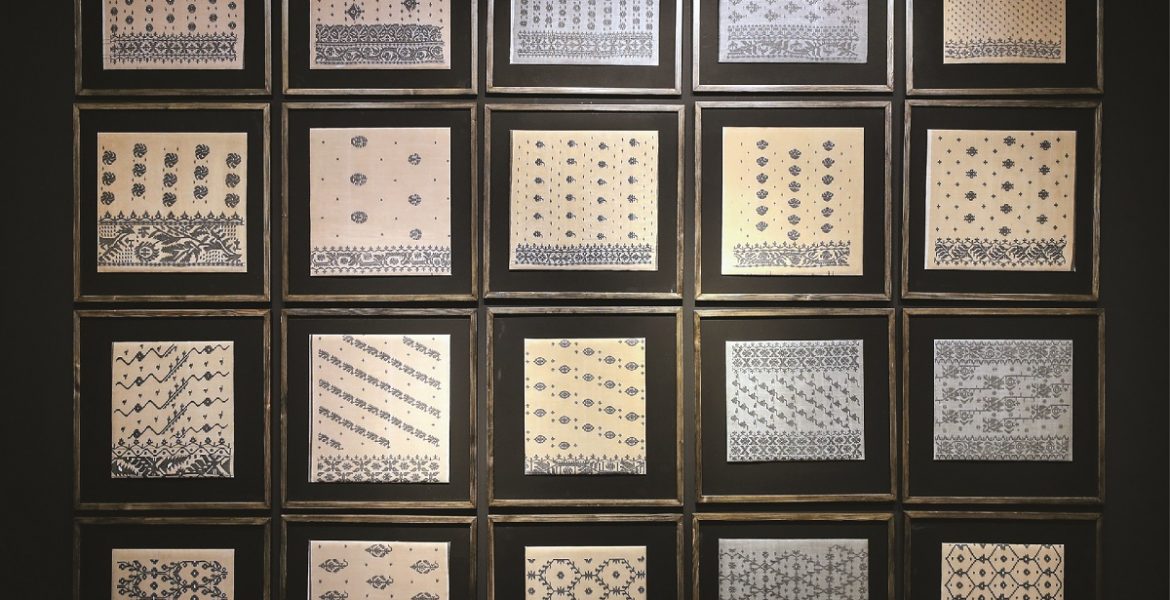The Jamdani Festival has beautifully displayed the intricate work and the artistic prowess of our weavers. Each piece of work will blow your mind if you knew how they were made. Two weavers working for days (even months) in complete harmony with handmade threads to create perfectly symmetrical designs all from memory. No scales, no blueprints, no room for errors. Only the sheer driving force of their minds and the techniques they were taught since childhood, this was nothing short of a miracle.
But amidst all the beautiful designs and pieces of history, it was an installation art that grabbed our attention. A clay pot resting in a water bath with threads around its neck and a thin bamboo embellished with more threads shooting from its mouth. Notice the dual symbolism of threads here. The ones in the bamboo represent the achievements of our weavers and the ones around the neck of the pot symbolises the shattered dreams and sufferings of their spouses. A profound piece of art accurately portraying the harsh reality of our weavers. Although they are the only beings standing between a 200 year old tradition and oblivion, there is no glory (at least monetary) here. They have nothing to show for their dedication and sacrifices and this is what ace designer and curator and Executive member of NCCB Chandra Shekhar Saha wanted to change through this exhibition. In the form of an extremely fascinating conversation, we got to learn more about the response and how he plans on moving forward.

The Buzz the Exhibition Created
The exhibition was nothing short of a success receiving overwhelming and somewhat unexpected response from the audience. “You could divide this into two categories,” claimed Saha. The first category was the response and acclaims that it received from foreign delegates of art and textile. Notable personalities like the President of the World Crafts Council Asia-Pacific Region Dr Ghada Hijjawi Qaddumi graced the event with her presence and considered it to be an international benchmark. “This was more expected than deserved given the talent of our weavers and the hard work they have put into each design,” Saha stated. The second category is the appreciation it received from Bangladeshi exhibition-goers who were left speechless after witnessing the genius of our weavers that most of us weren’t aware of. They had nothing but respect and admiration for these individuals who against all odds make the impossible possible. “And who wouldn’t have respect and admiration for them? They connect us with the past. Despite having no education, they weave 200 year old poems into sarees. Despite having no money, they hold on to traction and their values,” Saha exclaimed.
Due recognition for the weavers

Before discussing more about their future plans, Chandra Shekhar Saha shed some much needed light on the magnitude and gravity of the contribution of the weavers in our culture and society. “You need to understand that they deliberately decided to hold on to our heritage while most of us moved forward and indulged ourselves in the fruits of progress and development. They could have easily done the same and led better and more financially stable lives but they didn’t and for that they deserve all the plaudits in the world,” he added. He also explained how Bangladesh had countless traditions and practices similar to this that got lost with time. “Jamdani is a practice exclusive only to Bangladesh and you will not find it in any other corner of the world. You can’t even find it in most regions of Bangladesh, only a selected few,” he elaborated. He described that this art form can only be achieved by a handful of individuals who were bestowed with the genes by their forefathers and although they have been dormant for a few generations as evident by the declining quality of their work, Saha believes that their abilities have been activated once again so this is the best opportunity we will get to restore Jamdani in all its glory. The weavers are doing their part to show us that lost traditions can be revived, purity can be restored. So, it is now our turn to support them. We consumers and patrons have a certain responsibility towards them and much like them, we will need to take it upon ourselves to ensure that we can preserve this tradition. We need to begin by ensuring they have a safe place to work as over the years, the rise of noise pollution from power looms have had an adverse effect on their work (A taste of this disruptive sound was displayed to visitors of the exhibition). We need to ensure that they have adequate access to handmade threads. Furthermore, we will need to ensure that the weavers are being compensated fairly for their work and efforts. “Of course, the government has taken a few steps towards that direction but as I have mentioned earlier, we as consumers too have certain responsibilities towards them,” he added. On his concluding notes he expressed his gratitude towards Bengal Foundation, Aarong and the other foundations who have dedicated their resources to support our cause. “This exhibition was completely dedicated to our weavers and we have the desire to take it to India and Europe so that they can be celebrated internationally,” Saha concluded on an optimistic note.

